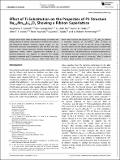Effect of Ti-substitution on the properties of P3 structure Na2/3Mn0.8Li0.2O2 showing a ribbon superlattice
Date
14/10/2022Author
Grant ID
EP/T019298/1
ep/l017008/1
EP/R023751/1
Keywords
Metadata
Show full item recordAbstract
Oxygen anion redox offers an effective strategy to enhance the energy density of layered oxide positive electrodes for sodium- and lithium-ion batteries. However, lattice oxygen loss and irreversible structural transformations over the first cycle may result in large voltage hysteresis, thereby impeding practical application. Herein, ribbon superstructure ordering of Li/transition-metal-ions was applied to suppress the voltage hysteresis combined with Ti-substitution to improve the cycling stability for P3-Na0.67Li0.2Ti0.15Mn0.65O2. When both cation and anion redox reactions are utilized, Na0.67Li0.2Ti0.15Mn0.65O2 delivers a reversible capacity of 172 mA h g−1 after 25 cycles at 10 mA g−1 between 1.6–4.4 V vs. Na+/Na. Ex-situ X-ray diffraction data reveal that the ribbon superstructure is retained with negligible unit cell volume expansion/contraction upon sodiation/desodiation. The performance as a positive electrode for Li-ion batteries was also evaluated and P3-Na0.67Li0.2Ti0.15Mn0.65O2 delivers a reversible capacity of 180 mA h g−1 after 25 cycles at 10 mA g−1 when cycled vs. Li+/Li between 2.0–4.8 V.
Citation
Linnell , S F , Kim , E J , Ma , L A , Naden , A B , Irvine , J T S , Younesi , R , Duda , L & Armstrong , R 2022 , ' Effect of Ti-substitution on the properties of P3 structure Na 2 /3Mn 0.8 Li 0.2 O 2 showing a ribbon superlattice ' , ChemElectroChem , vol. 9 , no. 19 , e202200929 . https://doi.org/10.1002/celc.202200929
Publication
ChemElectroChem
Status
Peer reviewed
ISSN
2196-0216Type
Journal article
Description
Funding: Faraday Institution (Grant Number(s): FIRG018); Engineering and Physical Sciences Research Council (Grant Number(s): EP/T019298/1, EP/L017008/1, EP/R023751/1); Energimyndigheten (Grant Number(s): 2020-005249); Spring 8 (Grant Number(s): 2019B1604).Collections
Items in the St Andrews Research Repository are protected by copyright, with all rights reserved, unless otherwise indicated.

